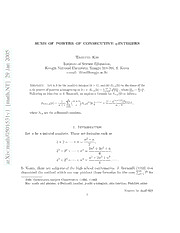
Sums of powers of consecutive q-integers PDF
Preview Sums of powers of consecutive q-integers
SUMS OF POWERS OF CONSECUTIVE q-INTEGERS 5 0 0 Taekyun Kim 2 n Institute of Science Education, a Kongju National University, Kongju 314-701, S. Korea J e-mail: [email protected] 9 2 ] T Abstract. Let n,k be thepositive integers(k >1), and letSn,q(k) be the sums of the N n-thpowersofpositiveq-integersuptok−1: Sn,q(k)= lk=−01ql[l]nq , where[l]q = qql−−11. . h Following an idea due to J. Bernoulli, we explore a formPula for Sn,q(k) as follows: t a [m Sn+1,q(k)= n+1 1 n n+i 1 βi,qqki[k]nq+1−i+ (1−q(nn++1)k1)βn+1,q, Xi=0(cid:16) (cid:17) 1 v where βi,q are the q-Bernoulli numbers. 1 3 5 1 1. Introduction 0 5 0 Let n be a natural numbers. There are formulas such as / h n2 +n t 1+2+···+n = , a 2 m 2n3 +3n2 +n : 12 +22 +···+n2 = , v 6 i X n4 +2n3 +n2 13 +23 +···+n3 = ,··· . r a 4 In Korea, these are subjects of the high school mathematics. J. Bernoulli (1713) first discovered the method which one can produce those formulae for the sum n lk for l=1 2000 Mathematics Subject Classification 11S80, 11B68 P Key words and phrases: q-Bernoulli number, p-adic q-integrals, zeta function, Dirichlet series Typeset by AMS-TEX 1 2 SUMS OF POWERS OF CONSECUTIVE q-INTEGERS any natural numbers. Let q be an indeterminate which can be considered in complex number field, and for any integer k define the q-integer as [k] = qk−1, cf. [1,2]. Note q q−1 that limq→1[k]q = k. In this paper we evaluatesums of powers of consecutive q-integers. For any positive integers n,k(> 1), let S (k) = k−1ql[l]n. Following an idea due to n,q l=0 q J. Bernoulli, we explore a formula for S (k) as follows: n,q P 1 n n+1 (1−q(n+1)k)β S (k) = β qki[k]n+1−i + n+1,q, n+1,q n+1 i i,q q n+1 i=0(cid:18) (cid:19) X where β are the q-Bernoulli numbers. i,q 2. Sum of the n-th powers of positive q-integers up to k −1 Let j be the positive integers. Then we easily see that (1) [j +1]2 −[j]2 = ([j] +qj)2 −[j]2 = qj(2[j] +qj). q q q q q By (1), we have k−1 k−1 [2k] (2) [k]2 = ([j +1]2 −[j]2) = 2 qj[j] + q. q q q q [2] q j=0 j=0 X X Hence, k−1 [2k] 1 (3) qj[j] = [k]2 − q . q q [2] 2 q j=0 (cid:18) (cid:19) X By the same method of Eq.(1), we easily see that (4) [j +1]3 −[j]3 = 3[j]2qj+1 +3[j] qj +q3j. q q q q Thus we have k−1 1 1 [2k] 1[3k] (5) [j]2qj+1 = [k]3 − [k]2 − q − q. q 3 q 2 q [2] 3 [3] q q j=0 (cid:18) (cid:19) X TAEKYUN KIM 3 Example. For q = 9 in (5), we note that 10 2 2 9 9 9 9 9 9 ( )2 +( )3 1+ +···+( )k 1+ +···+( )k−2 +··· 10 10 10 10 10 10 (cid:18) (cid:19) (cid:18) (cid:19) 3 2 1 1 1 1 1 1 1 = − − − . 3 1− 9 2 1− 9 1−( 9 )2 3 1−( 9 )3 ! (cid:18) 10(cid:19) (cid:18) 10(cid:19) 10 (cid:18) 10 (cid:19) Let n,k be the positive integers (k > 1) and let S (k) = k−1ql[l]n. Then we note n,q l=0 q that P n−1 k−1 n (6) i Si,qn−i(k) = [l+1]nq −[l]nq = [k]nq. i=0 (cid:18) (cid:19) l=0 X X(cid:0) (cid:1) By replacing n by n+1, we see that n n−1 n+1 n+1 (7) [k]nq+1 = i Si,qn+1−i(k) = i Si,qn+1−i(k)+(n+1)Sn,q(k). i=0(cid:18) (cid:19) i=0 (cid:18) (cid:19) X X Therefore we obtain the following: n−1 n+1 (8) (n+1)Sn,q(k) = [k]nq+1 − i Si,qn+1−i(k). i=0 (cid:18) (cid:19) X 3. q-analogs of Bernoulli polynomials In this section, we assume q ∈ C with |q| < 1. The q-Bernoulli polynomials β (x) n,q are defined by means of the generating function F (t) as follows: q ∞ ∞ q −1 β (x) (9) Fq(t) = e1−tq −t qn+xe[n+x]qt = n,q tn, |q| < 1, |t| < 1 . logq n! n=0 n=0 X X In the case x = 0, β (= β (0)) will be called the q-Bernoulli numbers, cf. [1, 2]. By n,q n,q (9), we easily see that n n n n 1 n k (10) β (x) = qjxβ [x]n−j = qkx(−1)k. n,q j j,q q 1−q k [k] q j=0(cid:18) (cid:19) (cid:18) (cid:19) k=0(cid:18) (cid:19) X X 4 SUMS OF POWERS OF CONSECUTIVE q-INTEGERS In (9), (10), the q-Bernoulli numbers can be rewritten as q −1 (11) β = , (qβ +1)k −β = δ , 0,q k,q k,1 logq where δ is Kronecker symbol and we use the usual convention about replacing βi by k,1 β , cf. [1,2]. By (9), (10), and (11), we easily see that i,q ∞ ∞ ∞ k−1 tn−1 − ql+ke[l+k]qt + qle[l]qt = n ql[l]n−1 . n! ! l=0 l=0 n=1 l=0 X X X X Thus we have k−1 (12) β (k)−β = n ql[l]n−1. n,q n,q q l=0 X By (12), we obtain the following: k−1 1 n n+1 (1−q(n+1)k) (13) ql[l]n = qklβ [k]n+1−l + β . q n+1 l l,q q n+1 n+1,q l=0 l=0 (cid:18) (cid:19) X X In Eq.(10), we know that n k n k (14) β (x) = [x]n−kβ [x]l(q−1)l. n,q k q k,q l q k=0(cid:18) (cid:19) l=0 (cid:18) (cid:19) X X By (14), we easily see that k 1 (15) β (x)d[x] = (β (k)−β ) = S (k). n,q q n+1,q n+1,q n,q n+1 Z0 References 1. T. Apstol, Introduction to analytic number theory, Undergraduate Texts in Math., Springer- Verlag, New York, 1986. 2. T. Kim, q-Volkenborn Integration, Russian J. Math. Phys. 9 (2002), 288-299.
